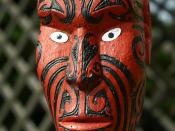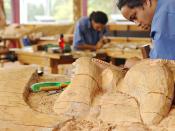New Zealand has a long history of Eurocentric appropriation and assimilation that has led koru and kowhaiwhai to become signifiers both of New Zealand Art and more widely New Zealand. It began with Sydney Parkinson's drawings of kowhaiwhai painted paddles produced during Captain Cook's 1769 voyage and continued to the present day with an excess of koru motifs advertising logos. Since the politically engaged 1980's this appropriation of motifs by Pakeha artists have spurned great debate in New Zealand. Pakeha artists have been seen by many to have created works using koru and kowhaiwhai problematically placing the motifs in a distorted context. Further difficulties have arisen with the question about who owns this cultural capital and what rights people have over it, producing an antagonism between biculturalism and cultural sovereignty. This essay will examine Koru and Kowhaiwhai and look at the appropriation debate that has centred on the work of three Pakeha artists, Theo Schoon, Gordon Walters and Colin McCahon.
The koru, also known as Pitau, is a curve with a bulb at the end, a shape used among many cultures but when rotated and reflected in certain repetitive patterns it forms the distinctly Maori Kowhaiwhai scroll patterns. With many layers of spiritual meaning Kowhaiwhai illustrates whakapapa in a representational style, mainly depicting humans, birds and fish . There are various usages of Kowhaiwhai on numerous art forms including painting, tattooing and carving. Always a highly adaptable art, kowhaiwhai painting was initially developed through rock drawings that were then transferred to painting on artefacts such as hoe and waka huia and later to architectural elements. The transferral of Kowhaiwhai was a way to transfer mauri and mana that the artefacts and architecture held . In traditional kowhaiwhai painting colours of red, white and black also hold spiritual significance; red...



Koru and kowhaiwhai in New Zealand painting
Do you have footnotes as well as the Bibliography?
0 out of 0 people found this comment useful.